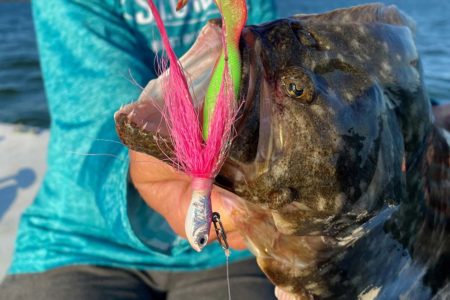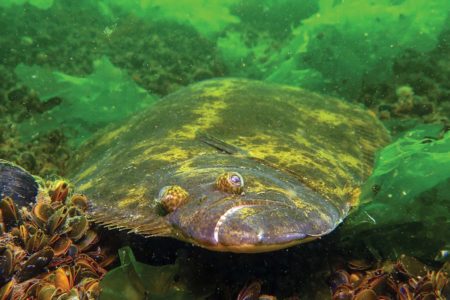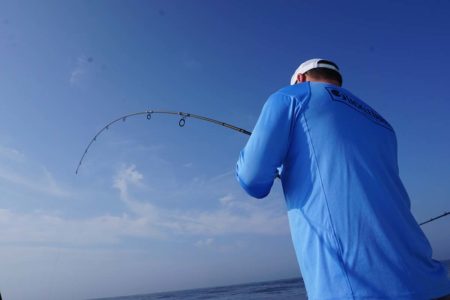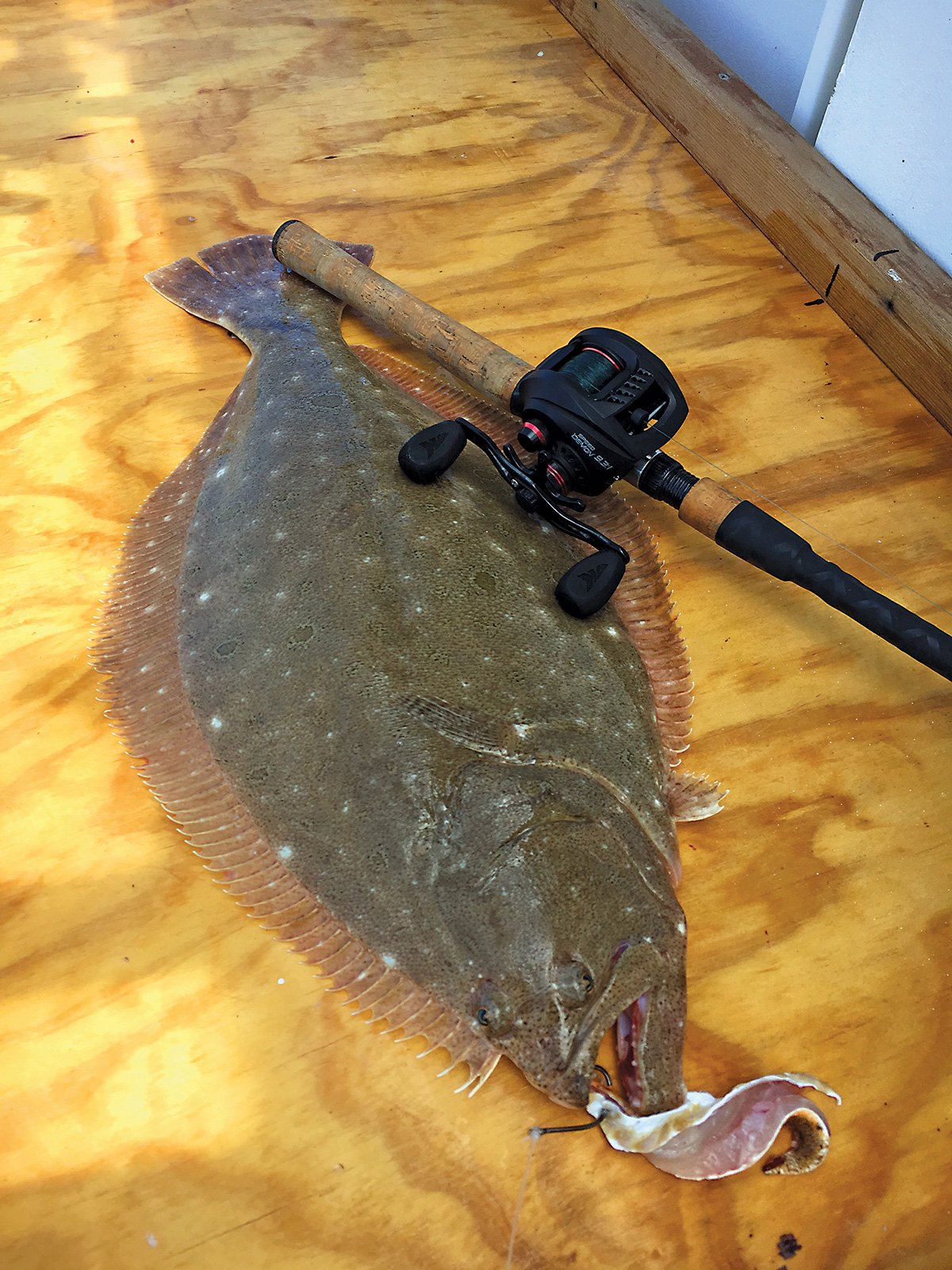
Fluke are one of the most popular gamefish targeted by anglers in our area. I say this mostly because any angler can have a great family day on the water while drifting and dreaming in pursuit of these great tasting, bottom dwellers. That being said, big fluke, doormats of 8 pounds and larger, are not easy to catch, and if one wishes to have consistent success with these jumbo fluke, it’s best to pay special attention to little details. Based on my experience, doormat fluke are both cunning and rare, and this combo of traits presents a major challenge for any dedicated fluke angler.
I have personally caught six fluke over 10 pounds, and many, many more between 8 and 10 pounds. I’m not bragging about my skills for I know the main reason for my success is because I fish off the East End of the Island almost entirely. Our East End waters are home to many big fluke simply because of the abundant bait and structure that abounds there. That being said, all Long Island waters host areas where big fluke are present for at least a portion of the season. It’s up to you to put the pieces together to have success in your home waters. However, in my opinion, if you want to tilt the odds in your favor for a doormat fluke, head east.
I can assure you that when a true doormat comes into view from the deep, it’s a sight that gets the heart thumping. A friend of mine, Bob Petersen, has landed the biggest fluke so far on my boat, the Grand Slam, and this behemoth pulled the scale down to 13.65 pounds several hours after being landed. When I saw this fish appear on the surface, I was awed by both its size and girth. I originally had a medium sized fluke net in my hands, but when I saw that fish, I immediately dropped that net to the deck, and lunged for my larger striper net because there was no way that doormat was going to fit in my basic fluke-sized net. Believe me, even though I wasn’t on the rod, my heart was racing as I scooped up that monster fluke.
My day starts by rigging up two different outfits to use at various times of the day. The first rod, a medium action conventional outfit capable of handling sinker weights to 10 ounces, is rigged with a simple 3-way rig. My main line, 30-pound braid, is tied directly to a 1/0 3-way swivel. To another eye of the 3-way, I add a 3- to 4-foot leader of 40-pound fluorocarbon with a 5/0 beak style hook tied onto the end of the leader. On the hook leader, in front of the hook, I always place a bucktail riveted teaser in white, chartreuse or pink. The final eye of the 3-way swivel gets a 6-inch monofilament sinker loop to which I attach the lightest sinker I can use in order to keep contact with the bottom. This is the rod and rig I use when the drift is pushing 2 knots and faster.
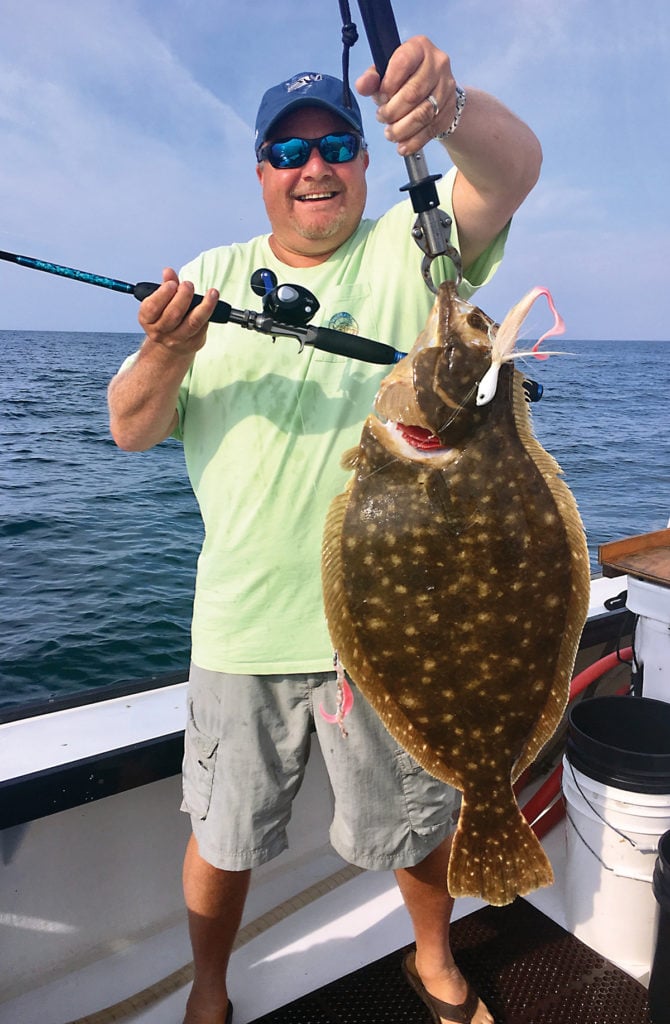
Fresh bait is the key. I like to use fresh local squid whenever I can get it. I slice the squid into thin, pennant shaped strips of about 6 to 8 inches in length. Fresh squid is not always available, so if I can’t get it, I then use fresh strip baits prepared the same way from other fish such as bluefish, sea robins, sun dials, or from a just-caught keeper fluke. (Caution, NYSDEC rules say you can only use the white side of the fluke, and the rest of the fluke must remain intact.) I always remove some of the meat from the “meatier” fish strips. I do this to make the strips more streamlined. This allows me to keep sinker weights down. I only hook the strip bait once through the tip of the wider end of the strip. Do not wrap or weave the strip onto the hook because this kills the fluttering action of the strip bait that big fluke find very enticing. I always combo my strip baits up with a large spearing or sand eel. Finally, before dropping my rig to the bottom, I place my hooked bait in the water, and watch it drift to make sure it looks nice and natural while drifting, with no spinning.
Don’t expect a wallop of a strike when any fluke takes the bait. Most times a big fluke just mouths the bait, and glides along with the drift, making it difficult for novice anglers to feel the bite. However, one should be able to feel added weight on the end of the line. Once that extra weight is felt, I like to drop back some line to let the fluke swallow the bait. Twenty feet of line will do. Next, I lock up the reel and count to five, then point the rod tip at the water, and begin a slow lift towards the sky. At some point, the rod tip will bend from the weight of the fluke on the other end. At this point set the hook with a quick flick of the wrist. Hopefully, everything was done correctly, and a doormat is powerfully thumping on the end of the line.
My second outfit is rigged for bucktail jigging. I love bucktailing for fluke, but in my opinion, during the course of a day the successful times of bucktailing will be limited to when drift speed is below 2 knots. A huge key to catching big fluke on bucktails is the use of braided main lines between 15- to 30-pound test. My favorite braided lines are produced by KASTKING. This company has a variety of braids to fill any need an angler might have. I like braided lines for fluke bucktailing. They are extremely thin, sensitive and void of any stretch. This allows for the use of smaller, more appealing bucktails that cut through the water with minimal resistance, and dart enticingly along the bottom. My best success with big fluke always seems to occur when I can keep contact to the bottom with bucktails ranging from 2 to 4 ounces jigged along bottom structure in 60 to 70 feet of water.
I like a Penn Fathom 15 reel when jigging for fluke. A good over the counter compliment rod to this reel is a Penn Allegiance ALLINII 1530C7. Bottom line, when jigging fluke, I’d suggest choosing a rod that is light, yet powerful, with a stiff tip.
I must stress, a rod tip with power is needed to make bucktails in the 2- to 6-ounce range dance along the bottom when jigged. A soft tip rod, with a slow action, will bend and flex when jigging, and almost no action at all will be imparted on the bucktail.
I feel bucktails produce best when a teaser is added up above the jig. There’s something about this double profile rig that makes big fluke very aggressive. The bucktail/teaser rigs I use are frugal, but effective. I start with about 30 inches of 40-pound fluorocarbon leader. To one end of the leader I tie on a small barrel swivel, and to the other end I attach a medium sized snap swivel. The importance of the snap is twofold. First, the snap allows for quick bucktail changes. Second, after netting a big fluke, the jig and rig almost always gets tangled in the net. To get the rig out quickly, simply take the jig off the snap, and the whole tangled mess will be remedied in a flash. I complete the rig by tying in a large dropper loop about halfway between the snap and the barrel swivel. Onto this loop I slide on a white, yellow, or chartreuse riveted bucktail teaser, and then attach my teaser hook. I’m not interested in small fluke, so for my teaser hooks I use at least a 5/0 Mustad Big Gun Live Bait Hook (#10829BLN).
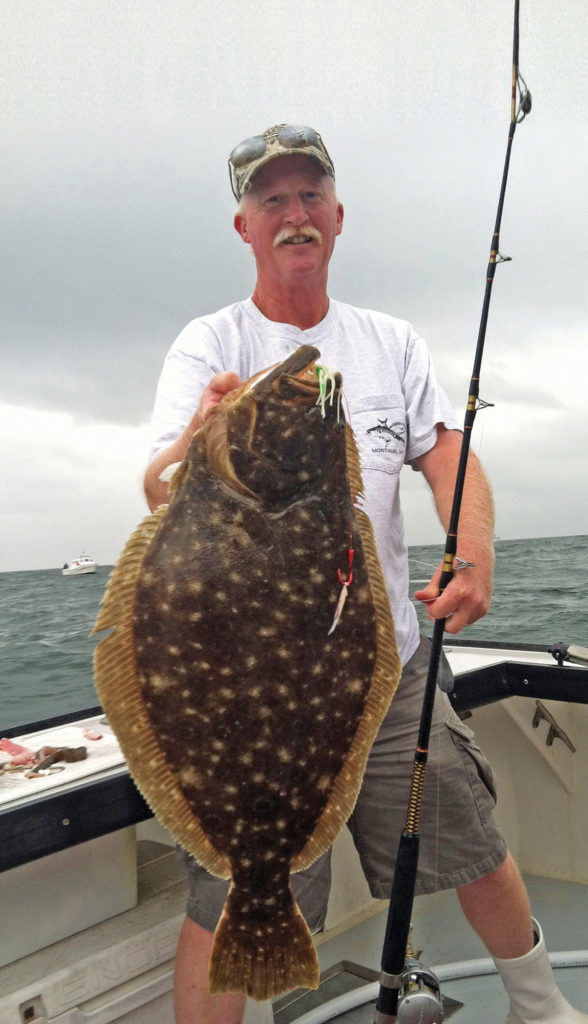
Always use the lightest bucktail jig that will stay in contact with the bottom. Work the jig continuously with small hops. Upon feeling a bite, immediately set the hook. If you miss the bite, quickly drop down and let the jig lie motionless for a few seconds, and then start jigging again. Usually the fluke will come back and take another swipe at the offering. Hopefully, this second hook set will prove successful.
Most anglers like to tip their bucktail jigs and teaser hooks with long strips cut from fish species, or assorted Berkley Gulp! baits. Yes, they all work on fluke. However, whether I’m using Gulp! or fish strips, I prefer smaller sized baits that won’t clog the hook point from the jigging action imparted on the bucktail. My favorite strip bait is cut from a freshly caught porgy. In fact, sometimes I even try to catch a few porgies before trying to catch fluke. Once caught the porgy is quickly filleted and stripped into 2- to 4-inch lengths. There’s something about the freshness of the strip, and goldish hue of the scales that drive big fluke crazy.
Consistently catching doormat fluke is the epitome of angling success for many local bottom fishing sharpies. While it’s a tough order to specifically target doormats for the whole season, I do believe the tips I just outlined certainly help any angler catch many more assorted sized fluke during the course of the season. Hopefully, some more of those fluke you catch will be of the doormat variety.
